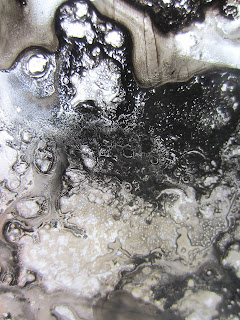For this brief I have continued my interest in biology to inspire my work. After leaving my biology degree to begin this course, I believe I can incorporate my understanding of this discipline into my practice. Biology is a strong passion of mine I feel this will help keep my practice developing throughout the briefs.
Memory and Materiality - For this workshop I used the memory of leaving my Biology degree as a starting point. This moment was an important turn in my life. I began looking at cognitive psychology and the theory that our mind works as a computer constantly uploading and saving information. This was how I felt I was being treated on the biology course. We were flooded with information in the first semester and I was struggling to process it. With this in mind I began copy and pasting information off the internet from course topics. I decided to recreate the confusion I felt by printing the text on the paper in all directions so the viewer is no longer able to read the text.
Looking at the mind and how information is processed, I began to focus on the brains biological content. The brain contains a network of neuron cells that transmit electrical pulses which converted to thoughts. A series of neuron drawings were produced using a mixture of ink, pen and wax. However, I felt these drawings I produced were too structured and I had too much control over the marks I was making. I felt this didn’t reflect the way our mind works. As our thoughts are often fluid and disorganized. With this in mind, I began working in a looser more fluid way. I wanted to produce more organic biological forms that are closer to a real human cell. Creating water washes and adding small dots of indian ink produced these looser forms I was interested in. The ink would bleed for a long distance and almost make the work look alive and grow uncontrollably. One aspect from this technique I focussed on was the small amount of control I had over the material used. The ink would find it’s own path and create marks beyond my control.
“Cells are the building blocks of life”
After researching more on cells I selected this quote as I felt it linked my individual interest in Biology and the aspect of society. Each cell I draw I see as a symbol of life. Like human life a cell is constantly growing, transforming and communicating. The cells in our body work as a synergy. A grouping of single cells form a living organism.
Briefly, I began to move away from paper and started to work on more clinical materials associated with science/medicine. I used acetate, glass and resin. Each material took on its own properties and from these materials I believe the acetate worked best. I created a PVA glue and salt wash and then added indian ink. The marks this created reflected cellular forms and It also gave me the option to experiment with light. If it wasn’t for the discovery of a new technique in the print workshop this is the idea I would have developed.
Print workshop - Continuing with the theme of letting materials move freely. I began experimenting with the linseed oil used to clean up etching ink. The prints created both beautiful yet unusual forms that reflected cells. Each cell had its own uniqueness yet had all been create using the same process.
During the “crit” sessions my peers recommended introducing colour to my work, up until this point I had only used black ink. Scientists stain cells to view them easily under a microscope. With these chemical colours in mind I began to created more prints. These prints had less visual impact and little contrast. Introducing colour over complicated the prints and moved away from the minimalist forms.
Final Piece - My final piece consists of multiple cell prints presented in a specimen-like way. The way the prints are presented reflect the logical, objective, statistical aspects of science. I’m interested in looking at society and people as being a statistic in a complete population. To begin with my initial composition was to have the cells positioned in an organic way. Moving freely up the wall and onto the studio floor. This way of presenting them became to overcrowded and the beauty of each cell print was being masked by the others.








No comments:
Post a Comment